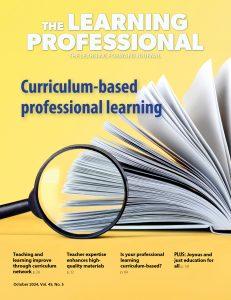“Should we be rolling out our new learning teams with every teacher across the school or start with just one or two teams?”
This question led to an interesting conversation at Learning Forward’s Summer Institutes in Denver, Colorado. The educator who asked had spent the previous two days studying Becoming a Learning Team (Learning Forward, 2017), a book we wrote recently about teacher teams learning in a cycle of continuous improvement.
As we talked about this question, several related questions arose, and others have come up since then. What do your teachers know already about the teaming process? What kind of support is available in your school if teams need help with facilitation, resources, or additional expertise? Are some teachers or grades at a particular level of readiness that would make piloting with one or two teams a smart move? Is the school’s leadership on board?
The session’s facilitators, a team from Centreville Elementary School in Fairfax County, Virginia, have been successful with learning teams and are still in the midst of implementation schoolwide. Former principal Dwayne Young said that, in the school’s initial steps into teaming, he knew he had key staff members ready to commit to a collaborative learning process because it was right for kids. And he also recognized that not all staff members were there yet.
So what if everyone is not on board? What if many are skeptical and others just uninterested? Trying to get 100% buy-in for a change is a monumental task. According to Tom Guskey, most educators change beliefs after they make changes in their practice and see evidence of impact on students.
Leaders should expect teachers to be skeptical of anything new. Too many new initiatives have been handed teachers to implement over the years with great promises and no support. Having a clear picture in mind of how the entire implementation process will operate is key to building interest and trust in the process.
Change leaders have options about how to approach an innovation. One is to start with the willing and, once there is evidence of changes in educator practice and results for students, bring others on board. This sets the stage for the time when it is no longer an option for educators to stay disengaged.
Another option comes from one of our all-time favorite principals. Sue Francis would permit choices when the evidence was not clear that the direction she wanted to take was in the best interest of student learning. If the evidence is solid, then everyone will begin the change effort at the same time.
If getting buy-in is the challenge, then identify small changes with potentially big impact in the beginning. Evidence of impact on students goes a long way in getting folks on board and increasing willingness to invest in even more significant changes.
Once educators change beliefs because they see changes in results for students, leaders will need to go deeper to identify the knowledge, skills, and new practices to implement. How will they learn them and who will coach them throughout the process until they can implement on their own?
Another issue to consider is how you create the conditions that will promote successful implementation. With implementation of schoolwide learning teams, school leaders also consider what supports they have in place to help teams succeed. Such supports might include:
- Protected, regular time in the workday for teams to learn;
- Coaches or other instructional support staff who can build teams’ collaboration skills, offer input on new lessons, or co-teach using new strategies;
- Access to additional content or pedagogical expertise within and beyond the district;
- An aligned vision that ties team learning to school and district improvement plans;
- Multiple relevant data sources and support in making meaning of the data; and
- A culture that prioritizes learning for all.
The participant who asked the original question about how to kick off his learning teams had already taken a great first step: making sure his educators had access to awareness-building resources (in this case, the Becoming a Learning Team book). Creating opportunities to build awareness is essential. Since he was already deepening his knowledge and skills around the innovation, he’s ready to take others on this learning journey.
Ultimately, we didn’t come up with one answer. As with most complicated questions, the answer is: It depends on your context. But this learning leader’s intentionality, inquiry orientation, and commitment to continuous improvement are critical to success.
This post originally appeared in Learning Forward’s PD Watch.






